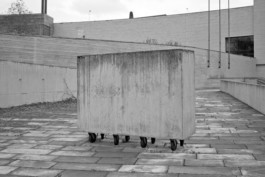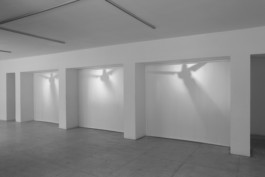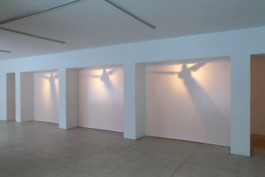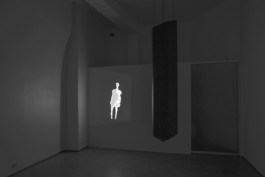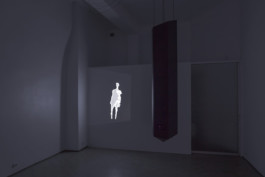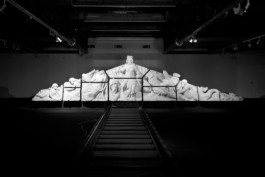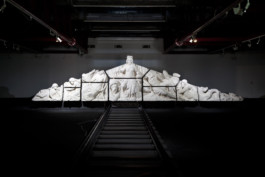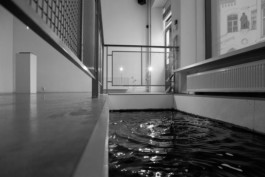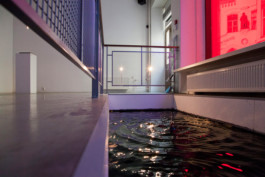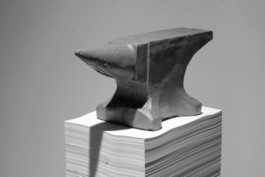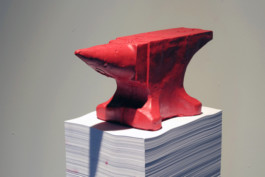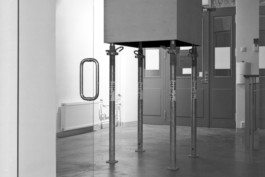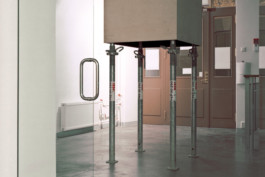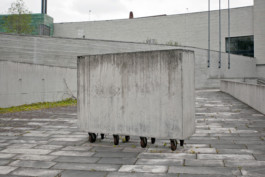Rebeka Põldsam
"Concrete cast Cow" ready for completion in 2006, the Kumu Art Museum. Kumu Art Museum is the basic materials of stone and concrete. Cold work is an elegant form of the game with a material that throws Evening question of faith in the importance, where the context may change the content of a single word - seemingly museum architecture Müürililleks wanders concrete element on wheels begins title cows after obsess about that if there really is a concrete inside a cow, or the artist, still a normal person .
Neeme Cold "in concrete cow" reminds immediately remembered Damien Hirsti formaldehüüli molded, cut in half and a glass box acrylated cow and calf installations "Mother and Child" (Divided), 1993 Hirsti carry terrible shock graafilisusega where you can see the guts of cows and that really, one animal larger than the other, may be regarded as two of art for the murdered animal family. The cold, however, the cape has taken the form of a rectangular area with some games and poured concrete, put the wheels down and one side of the tag, the concrete is poured cow. We do not see this cow, but maybe even there really is such a cow Hirstil? Why did the artist do anything right? Is the concrete is poured or conceptual pretty cow cow? Why a cow, and what does that mean? Perhaps the slaughterhouse had a cow concrete or concrete cast alive into a cow Neeme Cold metaphor for the position of creative artists in the museum? What is it supposed to mean? The artist's aim is for each of any successful: spectators begin to obsess about a number of issues that require immediate and clarity of the thinking.
“Betooni valatud lehm” valmis 2006. aastal Kumu kunstimuuseumi valmimise puhul. Kumu kunstimuuseumi põhimaterjalideks on kivi ja betoon. Külma teos on elegantne vormimäng materjaliga, mis viskab õhtu küsimuse uskumise olulisusest, kus kontekst võib sisu muuta vaid ühe sõnaga - pealtnäha muuseumiarhitektuuri müürilillena hajuv betoonelement ratastel hakkab pealkirjas mainitud lehma pärast painama, et kas tõesti on betooni sees lehm või kas kunstnik ikka on normaalne inimene.
Neeme Külma “Betooni valatud lehm” tuletab kohe meelde Damien Hirsti formaldehüüli valatud, pooleks lõigatud ja klaasist kastis akrüülitud lehma ja vasika installatsioonile “Mother and Child” (Divided), 1993. Hirsti teos šokeerib jubeda graafilisusega, kus on näha lehmade sisikond, ja et tõesti on üks loom teisest suurem, võib pidada kahte kunsti tarbeks mõrvatud looma perekonnaks. Neeme Külm aga on võtnud neljakandilise vormi mõningate pinnamängudega ja valanud betooni, pannud rattad alla ja kõrvale kinnitanud sildi, et betooni on valatud lehm. Me ei näe seda lehma, aga võib olla tõesti on sealgi lehm nagu Hirstil? Miks kunstnik midagi sellist küll teeks? Kas betooni on valatud päris lehm või kontseptuaalne lehm? Miks just lehm ja mida see tähendama peaks? Vahest on tapamajast tulnud lehm betoonis või elusalt betoonivalatud lehm Neeme Külma metafoor kunstnike loomingu positsioonist muuseumis? Mida see siis tähendama peaks? Kunstniku eesmärk on igastahes õnnestunud: vaatajat hakkavad painama mitmed küsimused, mis nõuavad otsekohe selgust ja väljamõtlemist.
